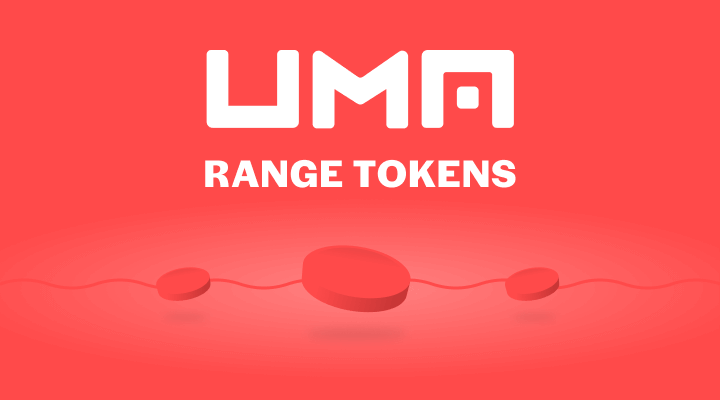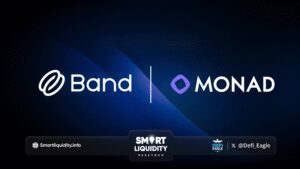UMA Range Tokens


UMA introduces the Range Token – a new treasury primitive that enables DAOs to access funds and diversify their treasury without directly selling their native tokens.
UMA’s flexible and secure infrastructure enables DAOs (decentralized autonomous organizations) to build custom tools to drive their community and manage their treasury. DAOs are now using KPI options to incentivize a desired activity or behavior as illustrated by Badger Dao’s Digg Options and Aragon’s KPI Options. Idle tokens in large DeFi treasuries are utilized to create and provide liquidity for call options on their native tokens for the benefit of their community as shown by UMA’s collaboration with Sushiswap and Balancer. DAOs have grown significantly in size, in numbers and in importance. UMA believes this trend will continue and the expanding and diverse needs of DAOs can be serviced by UMA’s financial contract templates and secured by its Optimistic Oracle. In this article we introduce a new treasury primitive that will help DAOs borrow funds without the risk of liquidation so that they can fund their operations and diversify their treasury. We call this structure a range token which acts similar to convertible debt in the venture capital world of traditional finance.
DAOs have become massive with some treasuries now valued in the billions of dollars. However, the majority of these assets are in the native token of the project with only a fraction in liquid assets or stable coins. Messari provides a good illustration of this in a recent tweet along with the chart below. Only holding one’s native token is all fine and well in a bull market, but what happens in a bear market? We had a taste of that in the recent sell-off where ETH/USD fell more than 50% from its highs while the value of many DAO treasuries declined even more. DAOs need to proactively prepare by diversifying their treasury to ensure they can fund their operations and achieve their protocol objectives. A recent proposal on Uniswap governance highlights this same thought.
The Challenge
Currently, the primary way a DeFi project accesses funding is through a sale of their native token. This is in contrast to traditional finance where there are many options which include equity sales, direct loans, bonds, and structured notes to name a few. Different instruments serve a different purpose and can create a unique capital structure for the entity. DAOs have many needs and challenges. DAOs may have restrictions or vesting schedules as to when tokens can be sold, but they need access to funds now to pay for expenses and compensate their team and community. DAOs want to sell their native tokens at a fair price and hopefully at a higher valuation in the future as they grow, but they want to secure some certainty now and avoid the volatile crypto markets. Ideally DAOs also want to minimize the immediate price impact to their token when divesting. A range token offers an alternative for diversifying a DAO’s treasury and overcomes some of these challenges mentioned above.
The Range Token
A range token can be viewed similarly to convertible debt. In the venture capital world, convertible debt allows startup companies to receive funding today without issuing equity upfront. The range token enables a DAO to use its native token as collateral to borrow funds. At maturity, if the debt is not paid, the range token holder is instead compensated with an equivalent amount of the collateral (the native token) using the settlement price of the native token to determine the number of tokens. For example, if the native token is trading at $25 at settlement, a 100 USDC debt would be settled with 4 tokens (100 / 25). This is similar to a yield dollar or a CDP (collateralized debt position); however, there are a couple of added features. A range token seller (the DAO in this case) cannot be liquidated and therefore, the number of tokens given to the range token holder is capped. The range token holder is effectively short a put option and will have exposure to the downside of the native token below a certain price. To compensate the range token holder for taking on this “default” risk, the holder is rewarded a call option on the native token. A minimum number of native tokens is given to the range token holder no matter how much the native token rallies. The combination of the structure creates a tradeoff between the seller and the buyer.
Why Buy Range Tokens?
Range tokens create a unique risk profile that best suit investors who believe in the long term success of a project. Range tokens are especially suited for passive investors who are willing to buy the project token on a significant sell-off and potentially earn meaningful yield while waiting in the range. As well, a range token investor is not overly concerned about missing gains in a significant rally because they are rewarded a call option. What is the general difference between buying the project token now versus the range token? Buying the project token provides immediate upside and downside exposure, whereas buying the range token pays a yield and only provides upside and downside exposure to the project token on significant moves. Investors can also get creative with the risk exposure of a range token by decomposing the parts. For example, an investor only looking for yield could buy the range token and sell out an equivalent call option to bet that the project token price will be relatively stable and in return he/she would essentially collect the premium on the put option and earn a sizable yield. It is interesting to highlight that a range token buyer may not even care about the upside exposure to the project and just believes the project will exist until maturity and return a healthy yield. This is almost similar to a traditional finance investor buying a high yield corporate bond in belief of its strong credit rating. In general, the range token opens up interesting risk profiles that are currently not available in DeFi.
Next Steps
Range tokens offer an alternative way for DAOs to diversify their treasury and they accompany the other treasury primitives built on UMA such as KPI options and call options. Range tokens will become a new asset class for DeFi investors and offer unique risk exposure similar to convertible debt. In the coming days, UMA will mint and distribute its own range token to provide a live example of how a DeFi project can utilize this tool and show how the structure would trade. Their follow up article will provide a more technical explanation detailing the payout equations and walk through how it is constructed and valued.
What is UMA?
UMA is a decentralized financial contracts platform built to enable Universal Market Access.
📰 INFO:
https://medium.com/uma-project/treasury-diversification-with-range-tokens-145d4b12614e




